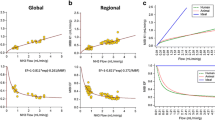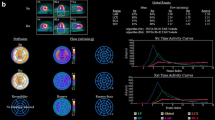Abstract
Purpose of Review
Myocardial blood flow (MBF) quantification with positron emission tomography (PET) is well validated and has established diagnostic and prognostic value for patient management. New cardiac dedicated solid-state single-photon emission tomography (SPECT) cameras using cadmium-zinc-telluride (CZT) crystals have better temporal and spatial resolution and increased count sensitivity than conventional SPECT systems and can measure MBF. We review recent validation studies using CZT technology for measurement of MBF and assess its readiness for clinical application.
Recent Findings
One preclinical study showed the accuracy of MBF measured using the CZT technology and conventional radiotracers versus microsphere data. Clinical studies have demonstrated the feasibility in patients and excellent correlations with coronary angiography and flow-wire studies, and PET imaging.
Summary
Measurement of MBF is possible with SPECT CZT systems and has been validated. Further studies are necessary to confirm the incremental value of MBF measurements with SPECT CZT to standard relative perfusion imaging for diagnostic accuracy and risk stratification.



Similar content being viewed by others
Abbreviations
- CAD:
-
coronary artery disease
- CZT:
-
cadmium-zinc-telluride
- PET:
-
positron emission tomography
- MBF:
-
myocardial blood flow
- MBFR:
-
myocardial blood flow reserve
- SPECT:
-
single-photon emission tomography
References
Papers of particular interest, published recently, have been highlighted as: • Of importance
Tomiyama Y, Manabe O, Oyama-Manabe N, Naya M, Sugimori H, Hirata K, et al. Quantification of myocardial blood flow with dynamic perfusion 3.0 Tesla MRI: validation with (15) O-water PET. J Magn Reson Imaging JMRI. 2015;42(3):754–62. doi:10.1002/jmri.24834.
Morton G, Chiribiri A, Ishida M, Hussain ST, Schuster A, Indermuehle A, et al. Quantification of absolute myocardial perfusion in patients with coronary artery disease: comparison between cardiovascular magnetic resonance and positron emission tomography. J Am Coll Cardiol. 2012;60(16):1546–55. doi:10.1016/j.jacc.2012.05.052.
Kikuchi Y, Oyama-Manabe N, Naya M, Manabe O, Tomiyama Y, Sasaki T, et al. Quantification of myocardial blood flow using dynamic 320-row multi-detector CT as compared with 15O-H2O PET. Eur Radiol. 2014;24(7):1547–56. doi:10.1007/s00330-014-3164-3.
Juneau D, Erthal F, Ohira H, Mc Ardle B, Hessian R, de Kemp RA, et al. Clinical PET myocardial perfusion imaging and flow quantification. Cardiol Clin. 2016;34(1):69–85. doi:10.1016/j.ccl.2015.07.013.
Schindler TH, Quercioli A, Valenta I, Ambrosio G, Wahl RL, Dilsizian V. Quantitative assessment of myocardial blood flow—clinical and research applications. Semin Nucl Med. 2014;44(4):274–93. doi:10.1053/j.semnuclmed.2014.04.002.
Garcia EV. Are SPECT measurements of myocardial blood flow and flow reserve ready for clinical use? Eur J Nucl Med Mol Imaging. 2014;41(12):2291–3. doi:10.1007/s00259-014-2924-2.
Wolk MJ, Bailey SR, Doherty JU, Douglas PS, Hendel RC, Kramer CM, et al. ACCF/AHA/ASE/ASNC/HFSA/HRS/SCAI/SCCT/SCMR/STS 2013 Multimodality Appropriate Use Criteria for the Detection and Risk Assessment of Stable Ischemic Heart DiseaseA Report of the American College of Cardiology Foundation Appropriate Use Criteria Task Force, American Heart Association, American Society of Echocardiography, American Society of Nuclear Cardiology, Heart Failure Society of America, Heart Rhythm Society, Society for Cardiovascular Angiography and Interventions, Society of Cardiovascular Computed Tomography, Society for Cardiovascular Magnetic Resonance, and Society of Thoracic Surgeons. J Am Coll Cardiol. 2014;63(4):380–406. doi:10.1016/j.jacc.2013.11.009.
Imbert L, Poussier S, Franken PR, Songy B, Verger A, Morel O, et al. Compared performance of high-sensitivity cameras dedicated to myocardial perfusion SPECT: a comprehensive analysis of phantom and human images. J Nucl Med. 2012;53(12):1897–903. doi:10.2967/jnumed.112.107417.
DePuey EG. Advances in SPECT camera software and hardware: currently available and new on the horizon. J Nucl Cardiol. 2012;19(3):551–81. doi:10.1007/s12350-012-9544-7.
Mouden M, Timmer JR, Ottervanger JP, Reiffers S, Oostdijk AH, Knollema S, et al. Impact of a new ultrafast CZT SPECT camera for myocardial perfusion imaging: fewer equivocal results and lower radiation dose. Eur J Nucl Med Mol Imaging. 2012;39(6):1048–55. doi:10.1007/s00259-012-2086-z.
Duvall WL, Croft LB, Godiwala T, Ginsberg E, George T, Henzlova MJ. Reduced isotope dose with rapid SPECT MPI imaging: initial experience with a CZT SPECT camera. J Nucl Cardiol Off Publ Am Soc Nucl Cardiol. 2010;17(6):1009–14. doi:10.1007/s12350-010-9215-5.
Lima R, Peclat T, Soares T, Ferreira C, Souza AC, Camargo G. Comparison of the prognostic value of myocardial perfusion imaging using a CZT-SPECT camera with a conventional anger camera. J Nucl Cardiol Off Publ Am Soc Nucl Cardiol. 2017;24(1):245–51. doi:10.1007/s12350-016-0618-9.
Ben-Haim S, Agostini D. Dynamic SPECT: evolution of a widely available tool for the assessment of coronary flow reserve. Eur J Nucl Med Mol Imaging. 2015 Feb;42(2):302–4. doi:10.1007/s00259-014-2929-x.
Ziadi MC, Dekemp RA, Williams K, Guo A, Renaud JM, Chow BJ, et al. Does quantification of myocardial flow reserve using rubidium-82 positron emission tomography facilitate detection of multivessel coronary artery disease? J Nucl Cardiol. 2012;19(4):670–80. doi:10.1007/s12350-011-9506-5.
Fiechter M, Ghadri JR, Gebhard C, Fuchs TA, Pazhenkottil AP, Nkoulou RN, et al. Diagnostic value of 13N-ammonia myocardial perfusion PET: added value of myocardial flow reserve. J Nucl Med. 2012;53:1230–4.
Herzog BA, Husmann L, Valenta I, Gaemperli O, Siegrist PT, Tay FM, et al. Long-term prognostic value of 13N-ammonia myocardial perfusion positron emission tomography added value of coronary flow reserve. J Am Coll Cardiol. 2009;54(2):150–6. doi:10.1016/j.jacc.2009.02.069.
Ziadi MC, Dekemp RA, Williams KA, Guo A, Chow BJ, Renaud JM, et al. Impaired myocardial flow reserve on rubidium-82 positron emission tomography imaging predicts adverse outcomes in patients assessed for myocardial ischemia. J Am Coll Cardiol. 2011;58(7):740–8. doi:10.1016/j.jacc.2011.01.065.
Murthy VL, Naya M, Foster CR, Hainer J, Gaber M, Di Carli G, et al. Improved cardiac risk assessment with noninvasive measures of coronary flow reserve. Circulation. 2011;124(20):2215–24. doi:10.1161/CIRCULATIONAHA.111.050427.
Majmudar MD, Murthy VL, Shah RV, Kolli S, Mousavi N, Foster CR, et al. Quantification of coronary flow reserve in patients with ischaemic and non-ischaemic cardiomyopathy and its association with clinical outcomes. Eur Heart J Cardiovasc Imaging. 2015;16(8):900–9. doi:10.1093/ehjci/jev012.
Cecchi F, Olivotto I, Gistri R, Lorenzoni R, Chiriatti G, Camici PG. Coronary microvascular dysfunction and prognosis in hypertrophic cardiomyopathy. N Engl J Med. 2003;349(11):1027–35. doi:10.1056/NEJMoa025050.
McArdle BA, Davies RA, Chen L, Small GR, Ruddy TD, Dwivedi G, et al. Prognostic value of rubidium-82 positron emission tomography in patients after heart transplant. Circ Cardiovasc Imaging. 2014;7(6):930–7. doi:10.1161/CIRCIMAGING.114.002184.
Hsu B, Chen FC, Wu TC, Huang WS, Hou PN, Chen CC, et al. Quantitation of myocardial blood flow and myocardial flow reserve with 99mTc-sestamibi dynamic SPECT/CT to enhance detection of coronary artery disease. Eur J Nucl Med Mol Imaging. 2014;41(12):2294–306. doi:10.1007/s00259-014-2881-9.
Shrestha U, Sciammarella M, Alhassen F, Yeghiazarians Y, Ellin J, Verdin E, et al. Measurement of absolute myocardial blood flow in humans using dynamic cardiac SPECT and 99mTc-tetrofosmin: method and validation. J Nucl Cardiol. 2017 Feb;24(1):268–77. doi:10.1007/s12350-015-0320-3.
Hsu B, Hu LH, Yang BH, Chen LC, Chen YK, Ting CH, et al. SPECT myocardial blood flow quantitation toward clinical use: a comparative study with 13N-Ammonia PET myocardial blood flow quantitation. Eur J Nucl Med Mol Imaging. 2017;44(1):117–28.
• Slomka PJ, Patton JA, Berman DS, Germano G. Advances in technical aspects of myocardial perfusion SPECT imaging. J Nucl Cardiol Off Publ Am Soc Nucl Cardiol. 2009;16(2):255–76. doi:10.1007/s12350-009-9052-6. Excellent review of new developments in SPECT and PET technology.
• Wells RG, Timmins R, Klein R, Lockwood J, Marvin B, de Kemp RA, et al. Dynamic SPECT measurement of absolute myocardial blood flow in a porcine model. J Nucl Med. 2014;55(10):1685–91. doi:10.2967/jnumed.114.139782. Only preclinical study validating the measurement of myocardial blood flow with SPECT CZT technology and is the basis for ongoing clinical development.
Timmins R, Klein R, Petryk J, Marvin B, Wei L, deKemp RA, et al. Reduced dose measurement of absolute myocardial blood flow using dynamic SPECT imaging in a porcine model. Med Phys. 2015;42:5075–83.
Wells RG, Marvin B, Poirier M, de Kemp R, Klein R, Ruddy T. Myocardial blood flow measured with a multi-pinhole SPECT camera: in vivo comparison to Rb-82 PET. J Nucl Med. 2016;57(supplement 2):284.
Alenazy AB, Wells RG, Ruddy TD. New solid state cadmium-zinc-telluride technology for cardiac single photon emission computed tomographic myocardial perfusion imaging. Expert Rev Med Devices. 2017;14(3):213–22. doi:10.1080/17434440.2017.1296763.
• Ben-Haim S, Murthy VL, Breault C, Allie R, Sitek A, Roth N, et al. Quantification of myocardial perfusion reserve using dynamic SPECT imaging in humans: a feasibility study. J Nucl Med. 2013;54(6):873–9. doi:10.2967/jnumed.112.109652. First clinical study to show the feasibility of measuring myocardial blood flow in patients with SPECT CZT technology.
Shiraishi S, Sakamoto F, Tsuda N, Yoshida M, Tomiguchi S, Utsunomiya D, et al. Prediction of left main or 3-vessel disease using myocardial perfusion reserve on dynamic thallium-201 single-photon emission computed tomography with a semiconductor gamma camera. Circ J Off J Jpn Circ Soc. 2015;79(3):623–31. doi:10.1253/circj.CJ-14-0932.
Ben Bouallègue F, Roubille F, Lattuca B, Cung TT, Macia JC, Gervasoni R, et al. SPECT myocardial perfusion reserve in patients with multivessel coronary disease: correlation with angiographic findings and invasive fractional flow reserve measurements. J Nucl Med Off Publ Soc Nucl Med. 2015;56(11):1712–7. doi:10.2967/jnumed.114.143164.
Nkoulou R, Nkoulou R, Fuchs TA, Pazhenkottil AP, Kuest SM, Ghadri JR, et al. Absolute myocardial blood flow and flow reserve assessed by gated SPECT with cadmium-zinc-telluride detectors using 99mTc-tetrofosmin: head-to-head comparison with 13N-ammonia PET. J Nucl Med Off Publ Soc Nucl Med. 2016;57(12):1887–92. doi:10.2967/jnumed.115.165498.
Sogbein OO, Pelletier-Galarneau M, Schindler TH, Wei L, Wells RG, Ruddy TD. New SPECT and PET radiopharmaceuticals for imaging cardiovascular disease. Biomed Res Int. 2014;2014:e942960. doi:10.1155/2014/942960.
Ma H, Li S, Wu Z, Liu J, Liu H, Guo X. Comparison of 99mTc-N-DBODC5 and 99mTc-mIBI of myocardial perfusion imaging for diagnosis of coronary artery disease. Biomed Res Int. 2013;2013:e145427. doi:10.1155/2013/145427.
Kim Y-S, Wang J, Broisat A, Glover DK, Liu S. Tc-99m-N-MPO: novel cationic Tc-99m radiotracer for myocardial perfusion imaging. J Nucl Cardiol Off Publ Am Soc Nucl Cardiol. 2008;15(4):535–46. doi:10.1016/j.nuclcard.2008.02.022.
Wells RG, Wei L, Petryk J, et al. Flow-dependent uptake of 123I-CMICE-013, a novel SPECT perfusion agent, compared with standard tracers. J Nucl Med Off Publ Soc Nucl Med. 2015;56(5):764–70. doi:10.2967/jnumed.114.151563.
Author information
Authors and Affiliations
Corresponding author
Ethics declarations
Conflict of Interest
Fernanda Erthal and Ronaldo Lima declare that they have no conflict of interest.
R. Glenn Wells reports grants from Natural Sciences and Engineering Research Council of Canada, and grants, non-financial support, and speaker honorarium from GE Healthcare, during the conduct of the study. He also reports grants from Advanced Accelerator Applications, outside the submitted work.
Terrence D. Ruddy reports grants from GE Healthcare, during the conduct of the study. He also reports grants from Advanced Accelerator Applications International and honoraria from GE Healthcare, outside the submitted work.
Human and Animal Rights and Informed Consent
This article does not contain any studies with human or animal subjects performed by any of the authors.
Additional information
This article is a part of Topical Collection on Cardiac Nuclear Imaging
Rights and permissions
About this article
Cite this article
Erthal, F., Lima, R., Glenn Wells, R. et al. Quantification of Myocardial Blood Flow with CZT SPECT Imaging: Is It Ready for Clinical Use?. Curr Cardiovasc Imaging Rep 10, 34 (2017). https://doi.org/10.1007/s12410-017-9432-2
Published:
DOI: https://doi.org/10.1007/s12410-017-9432-2




